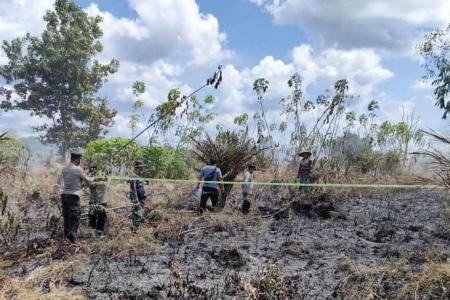Indonesia deploys over 20 helicopters to fire-prone provinces after hot spots appear
JAKARTA - Indonesia has deployed more than 20 helicopters to six fire-prone provinces in Sumatra and Kalimantan as a pre-emptive measure, after small-scale forest and plantation fires appeared in the past week.
The fires, which have prompted fears of haze returning to the region, have not spread, thanks to rain and fire-fighting efforts on the ground, said Indonesia's national disaster mitigation agency (BNPB).
"BNPB's helicopters - for surveillance and water bombing - have been on standby in Riau, Jambi in South Sumatra, West Kalimantan, Central Kalimantan and South Kalimantan," Dr Abdul Muhari, acting head of the agency's data, information and communication centre, told The Straits Times at the weekend.
Scattered hot spots were detected in West Kalimantan, Sumatra and Peninsular Malaysia late last week, based on satellite imagery, and moderate haze could be seen above the hot spot clusters in West Kalimantan, according to the Asean-specialised meteorological centre. The haze was no longer observed at the weekend.
"Fires emerged but remained on a small scale, around 5ha," Dr Abdul said. The weather this year was expected to be a far cry from the high fire-potential dry spell in 2015 and 2018, he said, referring to haze from forest fires in those years.
He added that despite such weather prospects, all fire-fighting equipment and human resources have been ready, and the alert will continue until September.
Mr Alfi Fahmi, an official at the Environment and Forestry Ministry tasked to help evaluate the Sumatra eco-region, noted hot spots emerged in Aceh and Riau, leading to forest and plantation fires, but they did not spread to more than 10ha.
Riau, an Indonesian province close to Singapore, has had a prolonged wet season due to climate change, making the seasons less predictable, Mr Alfi told ST.
Weather in Indonesia is split into two seasons - wet and dry - with the dry season in most regions from May to September, and rains between October and April.
Experts had warned about the "medium risk" of moderate haze returning to South-east Asia this year, as farmers and recalcitrant plantation companies could clear land by the illegal slash-and-burn method to cut costs, as opposed to using heavy equipment.
The Singapore Institute of International Affairs' Haze Outlook 2022, issued on June 28, said this year sees a higher risk, as record-high prices of palm oil and other commodities had incentivised farmers and companies to expand operations.

A photo from 2019 shows a farmer transporting the fruits of oil palms grown on peatland in Riau. PHOTO: ST FILE
The report cited non-governmental organisations as saying, however, that the haze would be short and limited this year, unlike in some previous years.
Indonesia has suffered haze episodes in most years between 1997 and 2015 as farmers and companies use illegal slash-and-burn techniques. The fires in 1997 and 2015 were especially big, worsened by severe drought.
After the 2015 fires, when the resulting haze shrouded Singapore and Malaysia as well, stepped-up law enforcement - including a shoot-on-sight order against fire-starters - and better fire-fighting equipment mandated for plantation firms have resulted in a significant decline in the scale of fires in the following years.
Indonesia's President Joko Widodo has also cracked the whip on local officials, issuing an unprecedented threat to sack any provincial police chief or local military commander in areas where fires spread uncontrollably.
Get The New Paper on your phone with the free TNP app. Download from the Apple App Store or Google Play Store now



